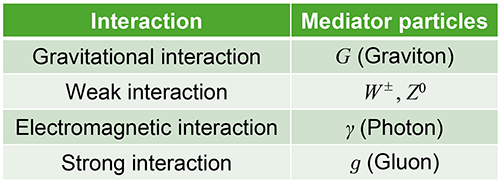First Observation of WZ Diboson Production
The W± particles and Z0 particles are gauge bosons that mediate the “weak interaction.” According to the Standard Model of particle physics, as shown in Table 1, there are four fundamental interactions (forces) in nature, listed in order of increasing strength: “gravitational interaction,” “weak interaction,” “electromagnetic interaction,” and “strong interaction.” Among these, the “weak interaction,” which we will introduce here, causes phenomena such as the β-decay of atomic nuclei. In particle physics, interactions occur through the exchange of mediator particles (gauge bosons), and in the case of the “weak interaction,” the W± and Z0 particles serve this role. Therefore, investigating their production processes in detail leads to a deeper understanding of interactions. If experimental results differ from theoretical calculations, it suggests the existence of “new physics” that has not been known before, making such investigations very important. Regarding the W± and Z0 particles, while their individual production processes have been extensively studied, simultaneous production of both particles has a very small production cross-section (production rate), and until now, only the production of W+W− pairs had been observed. However, in the CDF experiment, which Osaka City University is part of, the simultaneous production of W±Z0 pairs was observed for the first time, and their production cross-section was measured for the first time in the world.
The simultaneous production process of W±Z0 is shown in Figure 1. One process, as shown in Figure 1(a), involves the production of a Z0 particle in an intermediate state through the collision of quarks and antiquarks in protons and antiprotons, which then decays into W± and Z0 (s-channel). Another process, as shown in Figure 1(b), involves the production of W± and Z0 pairs through the exchange of quarks (antiquarks) during quark-antiquark collisions (t-channel). The process in Figure 1(a) is particularly important as it provides information on the three-point coupling of weak bosons, which mediate the “weak interaction.” If the coupling constant differs from the theoretical value, it may indicate that there is a “structure” in the seemingly single-point coupling, suggesting the presence of “new physics” or “unknown particles”.
In the CDF experiment, this time, using 1.1 fb−1 of proton-antiproton collision data, we analyzed events where both W± and Z0 decay into leptons (e, μ):
W± → ℓ±ν, Z0 → ℓ+ℓ− .
This analysis focused on events containing three leptons in total. Additionally, since neutrinos, which cannot be detected by the instrument, would be present in the final state, an anisotropy in the detected energy was also used as a signal indicator. Such events are rare in high-energy particle collisions, thus improving the signal-to-noise ratio. Careful identification of leptons led to the spectra shown in Figures 2 and 3. The points with error bars represent the data, while the colored histograms are predictions from Monte Carlo simulations. It is evident that the data cannot be explained without the contribution of W±Z0 production. Numerically, with an expected 2.7 background events and 12.5 signal events, 16 events were actually observed. From this, the production cross-section for W±Z0 pairs from proton-antiproton collisions was measured as:
| σ(pp → WZ) | = | 5.0 | +1.8 | (stat. + syst.) | pb . |
| −1.6 |
Incidentally, as of November 2006, this value is the smallest production cross-section measured for any reaction/production process worldwide.
Currently, we are increasing the statistics to challenge the measurement of the production cross-section for Z0Z0 pairs, which is expected to be even smaller.




